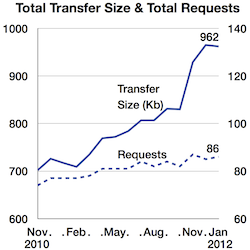
Sign In
News
The web is getting fatter and fatter, and we now have numbers to prove it. Twice a month, httparchive.org puts more than 10,000 popular websites on the scale and captures a variety of measurements. This example shows steady increases, over the past 15 months, in both webpage size and number of fetch requests per page.

Page Speed scores, a measurement of page load time (available at httparchive.org) worsened by 12 per cent over the same period.
In spite of all technological advancements to date, web pages now take longer than ever to waddle over the Internet and into our browsers. Desktop users with fast broadband connections can tolerate this waddle. For 2011 Q3, Gartner reported 115 million more smartphone users. The smartphone's high-latency 3G network and battery-powered CPU is no match for the mighty desktop, so what waddled before now crawls on a smartphone. Ironically, as the web got fatter, what we increasingly use to consume this content got weaker.
For a webapp, like a Bing or Google map, it only gets worse. And it has to do with our expectations.
We see a collection of webpages as a fancy book. When we click or gesture to another webpage, we use the metaphor of turning a page to decide how long we will wait. The answer is around two seconds (grab a book and see for yourself). A webapp is an application — not a webpage — and the light switch or doorbell is its metaphor. Push a doorbell and measure how long until you hear its chime.
We tolerate a two second waddle every time we click to another webpage. But, we expect a webapp — like a map — to jump to attention each and every time we gesture for more content.
The World-Wide-Web is now the World-Wide-Waddle, thanks in part to a few too many trips to the buffet table. Map APIs from Bing, MapQuest and Google support a well balanced Web experience. They're a tasty and low-calorie addition to any map application. But you must count calories. Be careful when you mix in JavaScript libraries (yes, I'm looking at you HTML 5), image files and Enterprise GIS map frameworks. They look delicious but some are packed with empty calories.
Consumers not only want but need lean maps, and will thank you if you can deliver.
On another topic, commercial users of Google Maps API are now subject to usage limits of 25,000 daily hits (or 2,500 for stylised maps). There are a some techniques that might reduce your usage, which I will discuss in a future column.